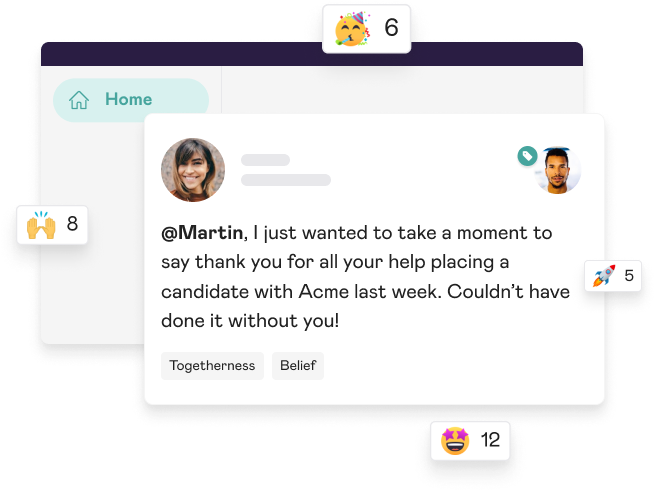Back in 2021, workers left their jobs at the highest rate in 20 years. The main reasons? Low pay, lack of development opportunities, and feeling disrespected.
To create a happy workforce and boost employee satisfaction, leaders must invest in their team members and take time to understand their unique employee experience. And, of course, they need to understand the basics of employee satisfaction.
How is employee satisfaction defined?
Employee satisfaction is a broad term used by the HR industry and describes how content an employee is with their job as a whole. It can include everything from their tasks and interactions with their colleagues to their overall opinion of the company.
Why is employee satisfaction important?
Employee satisfaction is incredibly important. It builds the foundations for a positive career and significantly encourages employees to stay put. What’s more, individual satisfaction also helps create a high-performing culture.
If you want your employees to feel comfortable, motivated and ready to shoot for the stars, you must satisfy their needs.
The benefits of satisfying employees
There are some very big positives to making sure that employees are satisfied, including:
- Higher productivity: When employees are satisfied and feel good about their position, they are more likely to excel.
- Reduced churn: Employees are less likely to go hunting for a new job when satisfied with their role and place in the company.
- Increased loyalty: When someone feels like they are being treated well by an organisation, they tend to feel more fondly towards it.
- Better engagement: The more satisfied employees are, the more likely they feel motivated to engage in their role, boosting productivity.
Employee satisfaction vs employee engagement: what’s the difference?
While employee engagement and employee satisfaction are closely linked, they are not the same. Engagement describes the extent to which an employee is connected to their job and company, while satisfaction describes how they feel about their role now and in the future.
The two can also drive each other. The more engaged employees are, the more satisfied they are likely to be – and vice versa.
Employee satisfaction: the essentials
To ensure that employees are satisfied, some basic needs should be met. These include:
A role that suits their skills and ethos
There’s no point trying to jam a square peg into a round hole. While it’s very possible to train and expand skill sets, it’s also a good idea to recognise individuals’ natural talents and proclivities.
When people enjoy the role they have and the tasks they’re given, they are far more likely to thrive. A good leader will be able to identify an employee’s strengths and ensure they are allowed to play to them.
A good atmosphere
It’s hard to feel satisfied when everyone around you is disgruntled. That’s why creating a good working atmosphere is essential.
Employees are much more likely to feel satisfied and motivated when they look forward to coming to work in the morning and know that their colleagues feel the same way.
An alignment of values
Being confident that the work you do and the company you work for have values that align with your own can be a fantastic boost to overall feelings of satisfaction and well-being.
As a leader, it’s important to not only choose core company values but also communicate them in a way that helps employees understand and feel inspired by them.
Best practices to keep employee satisfaction high
Give your employees the foundations they need to build strong feelings of satisfaction.
Keep a close eye on employee development
For most employees, knowing that they have the opportunity to grow and expand their skills is a key driving factor for improving their satisfaction.
In a study by LinkedIn, an incredible 94% of employees said that they would
stay at a company longer if it invests in their career development – which indicates the importance of learning and development for the average worker!
Foster a strong company culture
Creating a good company culture is no small feat, but it can have massive benefits for satisfaction levels all around.
When people feel aligned with their company’s values and believe that they can successfully collaborate with their colleagues, they are well-placed to generate positivity and boost their satisfaction.
A human-centric company culture can be beneficial in improving satisfaction levels.
Be smart with your hiring practice
If you want to grow high levels of satisfaction for all of your employees, then it’s a good idea to look at your recruitment practices.
Why? According to research from Bamboo HR, ‘the people at work’ was the most common topic for employees who were questioned about their overall satisfaction.
When hiring, take the time to check a candidate is a good culture fit and tick off all other requirements – this will help to create better feelings of harmony and satisfaction throughout.
Recognise and reward employees
Who doesn’t feel good when someone recognises their good work? An employee reward and recognition program can greatly impact job satisfaction by reminding people how much they’re appreciated.
The Transforming Workplaces Through Recognition report found that when employees were recognised, they were more satisfied at work and without.
44% are more likely to be “thriving” overall when they feel appreciated. The power of appreciation can’t be over-estimated; harness it for your employees.
Transform your culture with Mo

- Improve employee engagement scores
- Reduce employee churn
- Build a collaborative culture
Mo is an employee recognition and engagement platform that can help leaders improve collaboration and morale, reduce employee churn and drive change.
Our platform creates a vibrant culture by developing team habits, encouraging people to celebrate success, recognise results and appreciate colleagues. Your complete toolkit for connecting and motivating teams in the new world of work. Book a demo with our team today.




